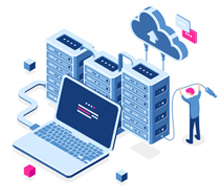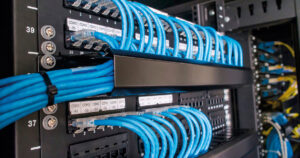
In today’s rapidly evolving digital landscape, enterprises are under growing pressure to become more agile, efficient, and data-driven. Businesses no longer compete solely on products or services—they compete on how effectively they can leverage technology to create seamless operations, deliver superior customer experiences, and innovate faster. Integrating IT solutions across all levels of an organization has therefore become the cornerstone of building a smarter, connected enterprise.
From cloud computing and IoT to AI-driven analytics and automation, modern IT integration enables organizations to unlock new efficiencies and make data-backed decisions with precision. This article explores how integrating IT solutions drives enterprise connectivity, the benefits it brings, the challenges companies face, and best practices for achieving digital synergy across systems and teams.
The Foundation of a Connected Enterprise
A connected enterprise is one in which people, processes, and technologies are linked together to enable smooth communication, efficient operations, and informed decision-making. Integration lies at the heart of this concept. Rather than operating in silos, systems across departments—such as finance, operations, marketing, and supply chain—are interconnected through shared data and unified platforms.
What Is IT Integration?
IT integration refers to the process of connecting different software applications, databases, and technology systems so they can function as one cohesive ecosystem. This allows data to flow seamlessly between departments, eliminates redundancies, and ensures that all business units have access to the same real-time information.
For example, when an ERP (Enterprise Resource Planning) system is integrated with CRM (Customer Relationship Management) and supply chain management platforms, businesses gain a 360-degree view of their operations—from procurement to customer engagement. This not only boosts productivity but also improves strategic agility and responsiveness.
The Shift Toward Intelligent Enterprises
The concept of a “smart enterprise” goes beyond simple connectivity. It involves using integrated IT systems infused with automation, artificial intelligence, and data analytics to enable smarter decision-making.
Key Drivers of the Shift
-
Digital Transformation Pressure:
Global competition and shifting market dynamics have pushed organizations to digitize core processes. Integration enables seamless adoption of digital technologies without disrupting legacy systems. -
Data as a Strategic Asset:
Modern enterprises collect massive volumes of data from diverse sources. Integration ensures that this data is consolidated and transformed into actionable insights rather than scattered across multiple systems. -
Customer-Centricity:
Businesses are realizing the importance of delivering consistent, personalized experiences. IT integration bridges the gap between customer data points—sales, marketing, and service—enabling unified customer engagement strategies. -
Operational Efficiency:
Manual processes, duplicate data entry, and communication breakdowns hinder productivity. Integrated IT ecosystems streamline workflows and automate routine tasks, freeing employees to focus on higher-value initiatives.
Core IT Solutions That Enable Integration
Creating a connected enterprise involves leveraging a combination of technologies that work together harmoniously. Below are some of the most critical IT solutions driving integration today:
1. Cloud Computing
The cloud is the backbone of modern IT integration. By hosting applications and data on cloud platforms, businesses can ensure easy accessibility, scalability, and collaboration across geographies. Cloud integration platforms (such as AWS, Microsoft Azure, and Google Cloud) also simplify the connection of on-premises systems with cloud-based services.
Cloud computing enables flexible deployment models—public, private, or hybrid—allowing enterprises to optimize performance and cost-efficiency. Moreover, cloud APIs (Application Programming Interfaces) allow disparate systems to communicate and exchange data seamlessly.
2. Enterprise Resource Planning (ERP)
ERP systems integrate core business processes such as finance, human resources, supply chain, and production into a single unified platform. When connected with other IT solutions like CRM or Business Intelligence (BI) tools, ERP systems provide holistic visibility and control across operations.
3. Internet of Things (IoT)
IoT devices generate real-time data from equipment, sensors, and assets. When integrated with enterprise systems, this data can drive predictive maintenance, improve supply chain visibility, and enhance product performance. For instance, manufacturing companies can use IoT data to predict machinery failures and schedule maintenance before downtime occurs.
4. Artificial Intelligence and Machine Learning
AI and ML enhance IT integration by enabling systems to analyze patterns, automate decision-making, and predict outcomes. Integrated AI-driven platforms can process vast data sets, uncover trends, and recommend optimal actions—turning raw data into business intelligence.
5. Robotic Process Automation (RPA)
RPA automates repetitive tasks across multiple systems without human intervention. When combined with AI and data analytics, RPA becomes a powerful tool for streamlining workflows and improving accuracy. Integration ensures these automated processes align with broader enterprise objectives.
6. Application Programming Interfaces (APIs)
APIs are the connectors that make integration possible. They define how different software components should interact, allowing organizations to combine various applications and services efficiently. Modern API management platforms ensure security, scalability, and governance throughout the integration process.
Benefits of an Integrated IT Ecosystem
The impact of integrating IT solutions extends across all areas of an enterprise. When executed effectively, integration fosters innovation, collaboration, and growth. Here are some of the major benefits:
1. Enhanced Collaboration and Communication
Integration breaks down silos, allowing teams to share data and insights effortlessly. Employees across departments can access real-time information, collaborate on shared goals, and align strategies more effectively.
2. Improved Decision-Making
With consolidated data and advanced analytics, enterprises gain a single source of truth. Decision-makers can identify trends, track performance, and make informed choices backed by accurate, up-to-date data.
3. Operational Efficiency
By automating workflows and reducing manual intervention, integrated systems streamline operations. Tasks that once took days can now be completed in minutes, reducing costs and freeing resources for innovation.
4. Enhanced Customer Experience
Integration provides a 360-degree view of the customer journey—from marketing to sales and support. This unified view enables personalized communication, faster response times, and improved satisfaction.
5. Scalability and Agility
Integrated IT infrastructures can adapt to new technologies and business requirements with ease. Whether expanding into new markets or adopting emerging tools, a connected enterprise can scale seamlessly.
6. Risk Management and Compliance
Integrated systems offer better visibility into data governance, security, and compliance requirements. Automated monitoring and reporting make it easier to identify potential risks and ensure regulatory compliance.
Challenges in IT Integration
While the benefits are significant, integrating IT systems across a large enterprise is not without challenges. Understanding these obstacles helps organizations prepare and plan more effectively.
1. Legacy Systems
Many enterprises still rely on outdated systems that were not designed for integration. Connecting these with modern platforms can be complex and costly.
2. Data Silos
Disparate databases and incompatible formats can make data sharing difficult. Without proper data governance, integration efforts can result in inconsistencies and inaccuracies.
3. Security Concerns
Integrating multiple systems increases the number of access points, which can expose vulnerabilities if not managed carefully. Data protection and cybersecurity must be top priorities.
4. Cost and Resource Constraints
Integration projects often require significant investment in software, infrastructure, and skilled personnel. Smaller organizations may struggle to balance these costs with other priorities.
5. Change Management
Technology integration often requires cultural and procedural change. Employees need to be trained to adapt to new systems and workflows, and leadership must foster a mindset of digital transformation.
Best Practices for Seamless IT Integration
To maximize the benefits and minimize challenges, organizations should approach integration strategically. Here are best practices for creating a truly connected enterprise:
1. Start with a Clear Strategy
Define the business goals driving integration—whether it’s improving efficiency, enabling data-driven decisions, or enhancing customer experience. A clear vision ensures technology aligns with organizational objectives.
2. Adopt a Modular Approach
Rather than replacing entire systems at once, adopt a modular integration approach. Connect systems gradually, starting with high-impact areas, and expand over time. This minimizes disruption and risk.
3. Leverage API-Driven Architecture
APIs are the building blocks of modern integration. Using standardized APIs simplifies connectivity, enhances interoperability, and enables faster deployment of new technologies.
4. Prioritize Data Governance
Establish clear policies for data accuracy, security, and accessibility. Ensure data is cleaned, standardized, and synchronized across all systems to maintain consistency.
5. Invest in Employee Training
Human adoption is critical to success. Provide training and support so employees can use integrated systems effectively and understand how new workflows improve their roles.
6. Monitor and Optimize Continuously
Integration is not a one-time project—it’s an ongoing process. Continuously monitor system performance, gather feedback, and make improvements to enhance connectivity and efficiency.
7. Choose the Right Integration Partners
Working with experienced IT solution providers can accelerate implementation and ensure best-in-class security and scalability. Look for vendors that offer flexible, cloud-based, and API-friendly platforms.
The Future of Integrated Enterprises
As technology continues to evolve, integration will become even more intelligent and automated. Emerging trends such as edge computing, 5G connectivity, and generative AI will further enhance real-time collaboration and predictive capabilities.
-
Edge computing will reduce latency by processing data closer to the source, enabling faster insights and response.
-
5G will provide the high-speed infrastructure required for IoT and cloud-based applications to function seamlessly.
-
Generative AI will empower enterprises to automate complex processes, generate insights, and even build custom integrations dynamically.
In the near future, the most successful enterprises will not just integrate technologies—they will integrate intelligence across every layer of their organization. This shift will redefine how businesses operate, innovate, and deliver value.
Conclusion
Integrating IT solutions is no longer a luxury—it’s a necessity for enterprises striving to remain competitive in a data-driven world. By connecting systems, automating processes, and enabling real-time insights, integration creates the foundation for a smarter, more agile, and customer-centric organization.
Enterprises that embrace integration with a strategic, forward-thinking approach will be best positioned to thrive in the digital age. The path to a smarter, connected enterprise begins with one simple principle: when technology works together, your business works smarter.

